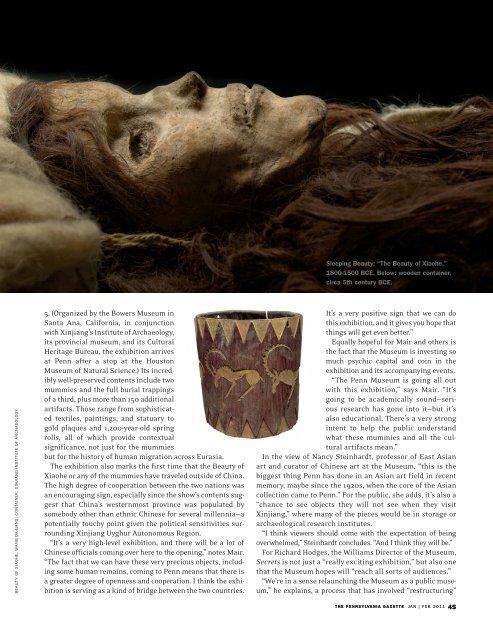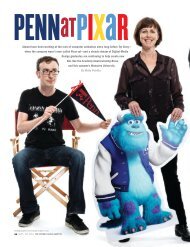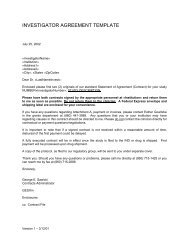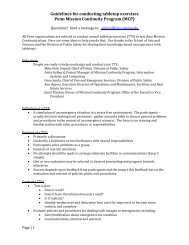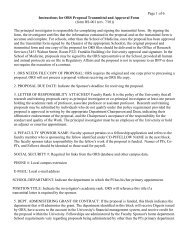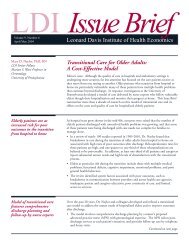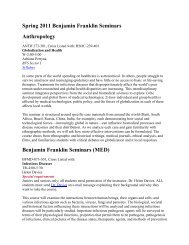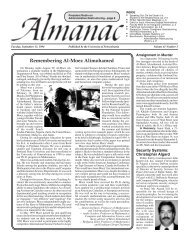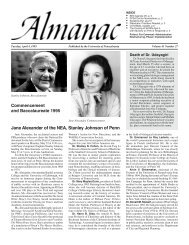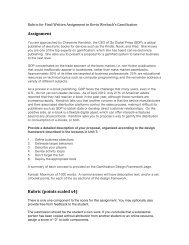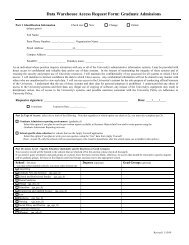Download this article (PDF) - University of Pennsylvania
Download this article (PDF) - University of Pennsylvania
Download this article (PDF) - University of Pennsylvania
Create successful ePaper yourself
Turn your PDF publications into a flip-book with our unique Google optimized e-Paper software.
Sleeping Beauty: “The Beauty <strong>of</strong> Xiaohe,”<br />
1800-1500 BCE. Below: wooden container,<br />
circa 5th century BCE.<br />
BEAUTY OF XIAOHE: WANG DA-GANG; CONTAINER: XINJIANG INSTITUTE OF ARCHAEOLOGY<br />
5. (Organized by the Bowers Museum in<br />
Santa Ana, California, in conjunction<br />
with Xinjiang’s Institute <strong>of</strong> Archaeology,<br />
its provincial museum, and its Cultural<br />
Heritage Bureau, the exhibition arrives<br />
at Penn after a stop at the Houston<br />
Museum <strong>of</strong> Natural Science.) Its incredibly<br />
well-preserved contents include two<br />
mummies and the full burial trappings<br />
<strong>of</strong> a third, plus more than 150 additional<br />
artifacts. Those range from sophisticated<br />
textiles, paintings, and statuary to<br />
gold plaques and 1,200-year-old spring<br />
rolls, all <strong>of</strong> which provide contextual<br />
significance, not just for the mummies<br />
but for the history <strong>of</strong> human migration across Eurasia.<br />
The exhibition also marks the first time that the Beauty <strong>of</strong><br />
Xiaohe or any <strong>of</strong> the mummies have traveled outside <strong>of</strong> China.<br />
The high degree <strong>of</strong> cooperation between the two nations was<br />
an encouraging sign, especially since the show’s contents suggest<br />
that China’s westernmost province was populated by<br />
somebody other than ethnic Chinese for several millennia—a<br />
potentially touchy point given the political sensitivities surrounding<br />
Xinjiang Uyghur Autonomous Region.<br />
“It’s a very high-level exhibition, and there will be a lot <strong>of</strong><br />
Chinese <strong>of</strong>ficials coming over here to the opening,” notes Mair.<br />
“The fact that we can have these very precious objects, including<br />
some human remains, coming to Penn means that there is<br />
a greater degree <strong>of</strong> openness and cooperation. I think the exhibition<br />
is serving as a kind <strong>of</strong> bridge between the two countries.<br />
It’s a very positive sign that we can do<br />
<strong>this</strong> exhibition, and it gives you hope that<br />
things will get even better.”<br />
Equally hopeful for Mair and others is<br />
the fact that the Museum is investing so<br />
much psychic capital and coin in the<br />
exhibition and its accompanying events.<br />
“The Penn Museum is going all out<br />
with <strong>this</strong> exhibition,” says Mair. “It’s<br />
going to be academically sound—serious<br />
research has gone into it—but it’s<br />
also educational. There’s a very strong<br />
intent to help the public understand<br />
what these mummies and all the cultural<br />
artifacts mean.”<br />
In the view <strong>of</strong> Nancy Steinhardt, pr<strong>of</strong>essor <strong>of</strong> East Asian<br />
art and curator <strong>of</strong> Chinese art at the Museum, “<strong>this</strong> is the<br />
biggest thing Penn has done in an Asian art field in recent<br />
memory, maybe since the 1920s, when the core <strong>of</strong> the Asian<br />
collection came to Penn.” For the public, she adds, it’s also a<br />
“chance to see objects they will not see when they visit<br />
Xinjiang,” where many <strong>of</strong> the pieces would be in storage or<br />
archaeological research institutes.<br />
“I think viewers should come with the expectation <strong>of</strong> being<br />
overwhelmed,” Steinhardt concludes. “And I think they will be.”<br />
For Richard Hodges, the Williams Director <strong>of</strong> the Museum,<br />
Secrets is not just a “really exciting exhibition,” but also one<br />
that the Museum hopes will “reach all sorts <strong>of</strong> audiences.”<br />
“We’re in a sense relaunching the Museum as a public museum,”<br />
he explains, a process that has involved “restructuring”<br />
THE PENNSYLVANIA GAZETTE JAN | FEB 2011 45


